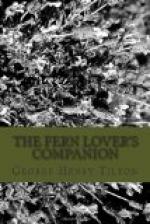[Illustration: Northern Oak Fern. Phegopteris Robertiana (From Water’s “Ferns,” Henry Holt & Co.)]
[Illustration: BROAD BEECH FERN. Phegopteris hexagonoptera]
(3) BROAD BEECH FERN
Phegopteris hexagonoptera
THELYPTERIS HEXAGONOPTERA
Fronds triangular, broader than long, seven to twelve inches broad, spreading more or less horizontally at the summit of the stipe; pubescent and often glandular beneath; pinnae fragrant, lanceolate, the lowest pair usually much larger than those above, having the segments elongated and cut into lobes. Basal segments decurrent and forming a many-angled wing along the main rachis. Fruit-dots small, near the margin.
The broad beech fern is usually larger than its sister, the long beech fern, and extends farther south, ranging from New England to Minnesota and southward to Florida. It is sometimes called “six-angled polypody.” According to Dodge it is most common in Rhode Island and Connecticut. It prefers rather dry, open woods. It is said to have a pleasant, ferny odor when bruised. August.
(4) LONG BEECH FERN
Phegopteris polypodioides. THELYPTERIS PHEGOPTERIS
Fronds triangular, longer than broad, four to six inches long, twice pinnatifid. Pinnae lanceolate, acuminate, the lowest pair deflexed and standing forward; cut into oblong, obtuse segments. Fruit-dots near the margin.
Compared with the broad beech fern this is the more northern species. While usually quite distinct in structure, it sometimes approaches its sister fern rather closely.
It prefers deep woods and shaded banks. Newfoundland to Alaska and southward to the mountains of Virginia. July.
[Illustration: Long Beech Fern. Phegopteris polypodioides]
[Illustration: The Long Beech Fern]
THE FRAGRANT FERN
Aspidium fragrans. Nephrodium fragrans
THELYPTERIS FRAGRANS. Dryopteris fragrans
Fronds four to twelve inches high, glandular-aromatic, narrowly lanceolate and twice pinnate or nearly so. Pinnae oblong-lanceolate, pinnate or deeply pinnatifid. Pinnules toothed or entire nearly covered beneath with the large, thin, imbricated indusia which are orbicular with a narrow sinus, having the margins ragged and sparingly glanduliferous. Stipe short and chaffy.
The fragrant fern grows on high cliffs among the mountains of northern New England. It is reported from scattered stations in northern Maine, from north of the White Mountains and from Sunapee Lake in New Hampshire, and in the Green Mountains south to central Vermont, New Brunswick and to Minnesota. Found also in Alaska and Greenland. This much-coveted fern has a singularly sweet and lasting fragrance, compared by some to strawberries, by others to new-mown hay and sweet brier leaves. We have seen herbarium specimens that were mildly and pleasantly odorous after several years. When growing the fern may be tested “by its fragrance, its stickiness and its beautiful brown curls.” Evergreen. Spores ripen the middle of August.




